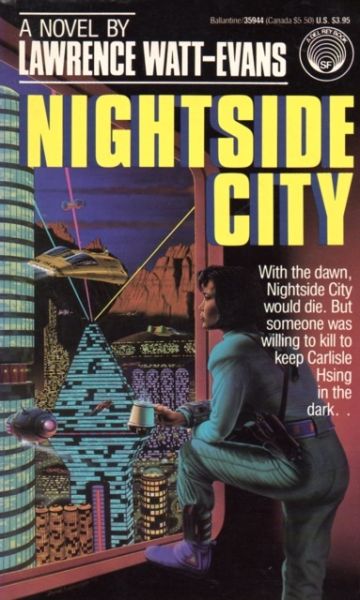In My Dreams I Have a Plan
Nightside City (Carlisle Hsing, volume 1)
By Lawrence Watt-Evans

22 Feb, 2024
1989’s Nightside City is the first of Lawrence Watt-Evan’s Carlisle Hsing hard-SF mystery novels, which are in turn a subset of Watt-Evan’s Shining Steel Universe.
Down-at-heel private detective Carlisle Hsing cannot be choosy about which cases to accept. Nevertheless, the case offered to her by Zarathustra Pickens is a new low. Not only is the pay laughably small, the case itself makes no sense. Why would someone be buying up doomed real estate?
But first! An infodump about the exoplanet on which the story is set.
Epimetheus orbits Eta Cassiopia A. The planet abounds in valuable mineral resources. While the planet is uncomfortably close to its star, initial surveys showed the planet to have a 1:1 spin-orbit resonance, tide-locked with one side forever in day and the other forever in night. Nightside City was built near the terminator, forever shadowed from the bright sun.
Initial surveys were wrong. Epimetheus is not tide-locked. It is almost tide-locked. The terminator moves one hundred and thirty-eight centimeters a day. One day, not too long from the present, the sun will rise over Nightside City. That will be the end of Nightside City.
The tenements about which Pickens is concerned will be among the first to see and be devoured by the rising sun. It makes no sense for someone to be methodically buying up real estate in that neighbourhood. Nevertheless, someone has; that someone wants exorbitant rents. It’s Hsing’s job to find out who that someone is.
That someone isn’t interested in having their identity revealed. Conveniently for Hsing, that someone isn’t as competent as they need to be to keep their project entirely under wraps. Hsing surmounts a multitude of barriers and eventually determines who is spending the money: Sayuri Nakada.
The Nakada clan is extremely wealthy, but not thanks to anything Sayuri has done. Sayuri is the clan’s most notable failchild, spoiled and self-indulgent. Sayuri’s track record of scandals and failed enterprises has won Sayuri her current position, sequestered in a doomed city on a backwater mining planet (that is to say, Epimetheus).
Sayuri has a very bold plan to prove her worth to her family. If all goes well, she will save Nightside and earn a fortune doing so. If all goes poorly, she may very well kill everyone on the planet. Either way, Sayuri does not need a PI snooping into her affairs.
While Sayuri might have some qualms about killing, her business associates don’t.
~oOo~
As I recall from a Usenet conversation, Watt-Evans consulted astronomy sources for his setting. Thus, while the system is a double star, the stars are sufficiently separated to allow stable orbits in the liquid water zone1. Through no fault of the author, the setting serves as an example of science marching on. Watt-Evans’ Eta Cassiopia is young. Currently, Eta Cassiopia is thought to be somewhat older than our sun.
138 cm a day may seem like something even crappy space probes would pick up. It’s pretty clear, though, that this is a setting where lowest bidders get a lot of contracts. For most planets, error bars larger than 138 cm a day likely suffice.
As to the plausibility of the investments here: being rich just means someone has a lot of money invested and can live off their income. This does not mean, as so many assume, that they are particularly brilliant. It is quite possible that they might pony up the cash for audacious projects like building a city near a terminator without doing the requisite due diligence. As happened here.
Why do have rich folk have a reputation for financial savvy, then? We can attribute this to the dartboard model of entrepreneurship2. A poor person might get one throw at a business venture. If it fails, they are done. A middle-class person might get a couple tosses. A few will get lucky. A rich person gets as many as they need, with the understanding that once they get their lucky shot nobody will dwell on all the times they missed.
Thus, from Sayuri’s point of view, all of her past failures were inconsequential one-offs. What matters is her inevitable triumph. A triumph that may not arrive, thanks to her cosseted upbringing and assumption of superiority. However, she may be correct in thinking that the costs of any failure will fall on other people.
As to the plot: some readers might find the ultimate explanation of what’s going on distressingly mundane. However, there’s a simple test I use for SF mysteries, a test that Nightside passes: can we replace the central McGuffin with an unmarked manila envelope without significantly affecting the plot? In this case, no: everything revolves around the peculiar characteristics of the exoplanet on which the story is set.
Nightside City should appeal to the intersection of two sets of readers: fans of competent detective fiction and fans of competent hard science fiction. In retrospect, I am surprised SF didn’t lose Watt-Evans to the larger and more lucrative mystery genre.
Nightside City is available here (Amazon US), here (Amazon Canada), here (Amazon UK), here (Barnes & Noble), here (Kobo), and here (Words Worth Books). I did not find Nightside City at Apple, nor could I find it at troubled Chapters-Indigo.
1: Unlike, say, Procyon. Or Sirius.
2: I am embarrassed to say I don’t remember who came up with it. Not me.
